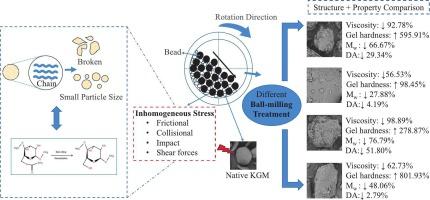通过球磨魔芋粉获得的独特粘度和凝胶硬度:对物理化学性质,结构和凝胶性质的见解
IF 9.8
1区 农林科学
Q1 CHEMISTRY, APPLIED
引用次数: 0
摘要
采用球磨法对魔芋粉进行改性,使魔芋粉具有不同的粘度和凝胶硬度。此外,结构变化与四种不同类型的球磨面粉的不同粘度和凝胶硬度有机械联系。结果表明,粘度的降低与分子量(Mw)的降低相关(p <; 0.05)。凝胶硬度的增强与粒径分布有关(D90, p <; 0.05)。优化尺寸(D90 = 125.6 μm)、高比表面积(212.38 m2/g)、低分子量(8.57 × 106 g/mol)和保持有序结构、结晶度指数不变(1.72)的协同作用使球磨后凝胶硬度达到8.02倍。差示扫描量热法显著改善了球磨粉的热稳定性。球磨通过摩擦、碰撞、冲击和剪切力诱导解聚,导致机械破碎和颗粒尺寸减小,表面微裂纹和细颗粒明显团聚。本文章由计算机程序翻译,如有差异,请以英文原文为准。

Distinct viscosity and gel hardness obtained by ball-milled konjac flour: Insights into physicochemical properties, structure and gel properties
Ball-milling, a sustainable mechanical processing technique, was employed to modify konjac flour to obtain distinct viscosity and gel hardness. Additionally, structural alterations were mechanistically linked to the distinct viscosity and gel hardness of four types of ball-milled flour. The results showed that the decline in viscosity was correlated with the reduction in molecular weight (Mw) (p < 0.05). The enhancement of gel hardness was associated with particle size distribution (D90, p < 0.05). Optimal gel hardness (8.02-fold) after ball-milling resulted from synergistic effects of optimized dimensions (D90 = 125.6 μm), combined with a high specific surface area (212.38 m2/g), low Mw (8.57 × 106 g/mol) and preserved ordered structures with an unchanged crystallinity index (1.72). Notably, differential scanning calorimetry significantly improved thermo-stability of ball-milled flour. Ball-milling induced depolymerization through frictional, collisional, impact and shear forces, leading to mechanical fragmentation and particle size reduction with surface microcracks and pronounced agglomeration of fine particulates.
求助全文
通过发布文献求助,成功后即可免费获取论文全文。
去求助
来源期刊

Food Chemistry
工程技术-食品科技
CiteScore
16.30
自引率
10.20%
发文量
3130
审稿时长
122 days
期刊介绍:
Food Chemistry publishes original research papers dealing with the advancement of the chemistry and biochemistry of foods or the analytical methods/ approach used. All papers should focus on the novelty of the research carried out.
 求助内容:
求助内容: 应助结果提醒方式:
应助结果提醒方式:


